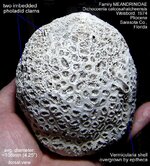Harry Pristis
Bronze Member
This is a soft-ball size coral head (a corallum) from the Pliocene of Florida. This specimen has a number of interesting features: The epitheca (the thin covering over the exterior) is removed -- probably ground down by tumbling on the sea bottom -- on the dorsal portion of the corallum. The proper walls of the calces (the individual corallites) are exposed in the damaged area (though these walls are indistinct in Dichocoenia).
On the left in the image, two clams of the Family Pholadidae ('rock-burrowing clams') are imbedded in the corallum. Hiatella arctica is one such pholadid known from these deposits.
On the right in the image, the epitheca has overgrown a Vermicularia shell.
Here is a handy glossary of coral-related terms (not all of them illustrated here):
- Calyx (plural calces): the bowl-shaped depression or "seat" in which the living polyp resides.
- Corallite: the skeleton produced by one polyp, which may or may not be part of a colony
- Epitheca: the outermost skeletal layer of a corallite which sometimes shows growth lines. Non-trabecular skeletal sheath along outside colony margin.
- Tabula (plural tabulae): a horizontal partition (or floor) dividing the corallite skeleton.
- Septum (plural septa): vertical blade or partition within the calyx of a corallite that are normally radially arranged.
- Dissepiment: small curved plate in a corallite near the tabulae that is convex inward and upwards.
- Mural pores: the small holes in the epitheca of some tabulate corals.
- Columella: an axial rod in a corallite usually formed by the fusion of two or more septa that typically forms a topographic prominence in the central part of the calyx.



